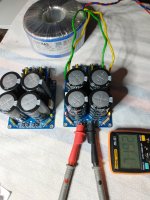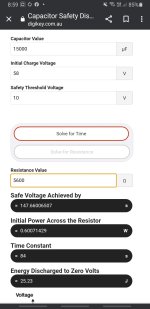Good news, I'm glad that you found the issue.
I'm not sure if you did but it's good practice to tin your wires before soldering this helps hold the fine wires together, and it makes it easy to connect them. It also ensures that all of the wires are making an electrical connection.
I'm not sure if you did but it's good practice to tin your wires before soldering this helps hold the fine wires together, and it makes it easy to connect them. It also ensures that all of the wires are making an electrical connection.
Second board up and running. Finally time to assemble the lot and put some music in it.

Hi Wkloppen,
If you have a little time to wait I am in the middle of making this video......
I think it will be useful at this stage of your build.....
If you have a little time to wait I am in the middle of making this video......
I think it will be useful at this stage of your build.....
Absolutely,.... I've left both channels switched on for the last 2 hours adjusting pots with small bits every 15 minutes. With the bias around 40 mv. I've noticed all the heatsinks being hottish and especially the driver heatsinks which I cant touch for a longer time. Is that normal?wait
w.
You might try orienting the heatsinks like they will be installed. I do know the main heatsinks are going to get hot sitting on a bench horizontal.
I wouldn’t expect the EF3-3 to have very warm drivers, but in the position on the bench you might not be getting much convection. The main heatsinks will warm the entire board. When I let my EF3-4 idle overnight in the vertical position, the drivers and main output sinks were both around 40-42C with a 22C ambient. The drivers were a bit warmer than the mains. This was with the old bias setup and 49V rails. Higher rails will raise the temperatures.
AB class idles warm. You can find more information on efficiency at various outputs in Self or Cordell and other references.
AB class idles warm. You can find more information on efficiency at various outputs in Self or Cordell and other references.
Truth is that fully assembled, the bias draw about 100ma per output transistor so the bleeders are just a safety feature for working on the circuit when the outputs are not there or the fuse(s) blow(s). The dissipated power is V^2/R. pick a value that runs at maybe 25% of the bleeder power rating. eg. 70^2 =4900 1k would give almost 5 watts. If you use a 1W resistor at 25% you would use something around 20k. This still give a long discharge time. A 1k 20W resistor can be used, but that wastes 5W per rail and will run warm.
If you can remember to discharge the supply when you work on it, then a 20k 1W might be fine. If you are like me, and try to repair a tube pentode output stage with the wire in one hand, the iron in the other, and the solder in your teeth, then you are in for a surprise. I only did that once 😎
If you can remember to discharge the supply when you work on it, then a 20k 1W might be fine. If you are like me, and try to repair a tube pentode output stage with the wire in one hand, the iron in the other, and the solder in your teeth, then you are in for a surprise. I only did that once 😎
Do you mean this ?Make sure that in the final version the top cover of the amplifier does never (ever) touch the round metal plate and bolt on top of the transformers. Otherwise your chassis will form a short-circuited transformer winding and (depending on whether both transformers are in or out of phase) a huge current will flow in this winding.
Nikos,
I like the way you bent over the heat sinks, did you just do it in a vice? I am reusing a case and will be a little cramped. I hope there is no negative reason not to. Bleader resistors are great during build and testing, I like to take them out when putting them into service and eliminate one more heat source inside the case.
Bill
I like the way you bent over the heat sinks, did you just do it in a vice? I am reusing a case and will be a little cramped. I hope there is no negative reason not to. Bleader resistors are great during build and testing, I like to take them out when putting them into service and eliminate one more heat source inside the case.
Bill
Last edited:
You can bend the heat sink like that when the PCB is in the upright position (parallel to the main heat sink). When the PCB is horizontal it will prevent air to flow along the heat sink. I would keep a bleader resistor, with higher value if necessary. You will be surprised to see how long these big capacitors can hold their charge when fuses blow.
I'm running 58 Volts with 2.2K (3W) with a calculated heat dissipation of 1.5 Watt. They still get rather hottish. I now understand with the outputs installed and a bias current of approx 100ma I don't need the bleeder R's anymore..........is that correct?The dissipated power is V^2/R. pick a value that runs at maybe 25% of the bleeder power rating. eg. 70^2 =4900 1k would give almost 5 watts
reg
willem
No, for safety you should have some no matter what. I like to think of it this way. If your power supply was not connected to anything and was in a closed chassis how long would it take you to open the chassis and potentially touch a lethal voltage.I don't need the bleeder R's anymore..........is that correct?
Size your bleeder resistors to keep you or someone else save.
If you use 2.5 minutes that will be a 5.6k resistor assuming 15,000uf rail cap.
Online calculator
Adjust the values to suit your conditions
Attachments
Thx!..Nice tool. Might replace them for 3.3K (3W). A little less hot (1W) and down from 58 to 10 volts in less then a minute.Online calculator
w.
- Home
- Amplifiers
- Solid State
- DIY Class A/B Amp The "Wolverine" build thread


